Abstract
The effects of methylenedioxyphenyl insecticide synergists on human health arise, not from their intrinsic toxicity which is relatively low, but from their dual effect on the oxidative detoxication or intoxication processes of the body. They are able to inhibit these reactions by two mechanisms. They are substrates for mixed function oxidation and, thus, compete with other xenobiotics for available enzyme, and an intermediate in their metabolism is able to bind with cytochrome P-450 to form an inactive complex which absorbs maximally at 455 nm. In addition, they are able to activate xenobiotic metabolism by induction (the increased synthesis and retention) of microsomal oxidative enzymes. Evidence for these effects is presented, including spectroscopic and enzyme kinetic data. Correlations with existing in vivo observations are outlined. The inhibition and induction of cytochrome P-450, the central enzyme in the metabolism of xenobiotics, thus provides the focus for consideration of methylenedioxyphenyl synergists as potential hazards.
Full text
PDF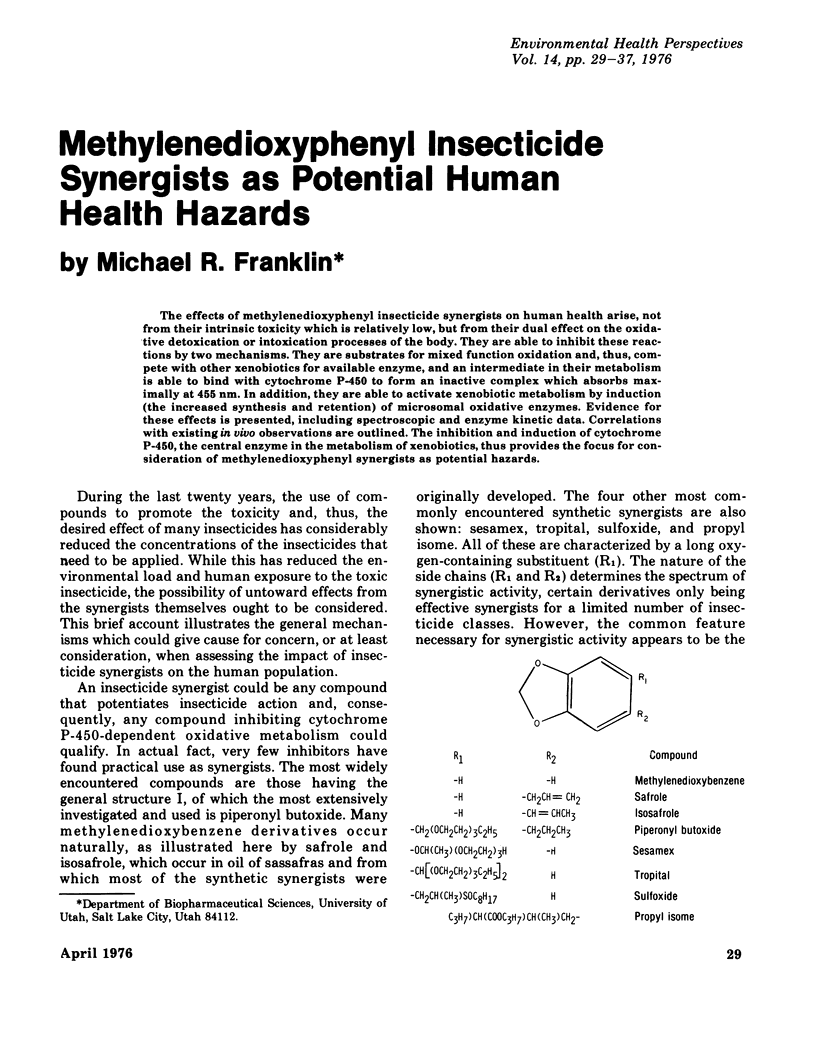
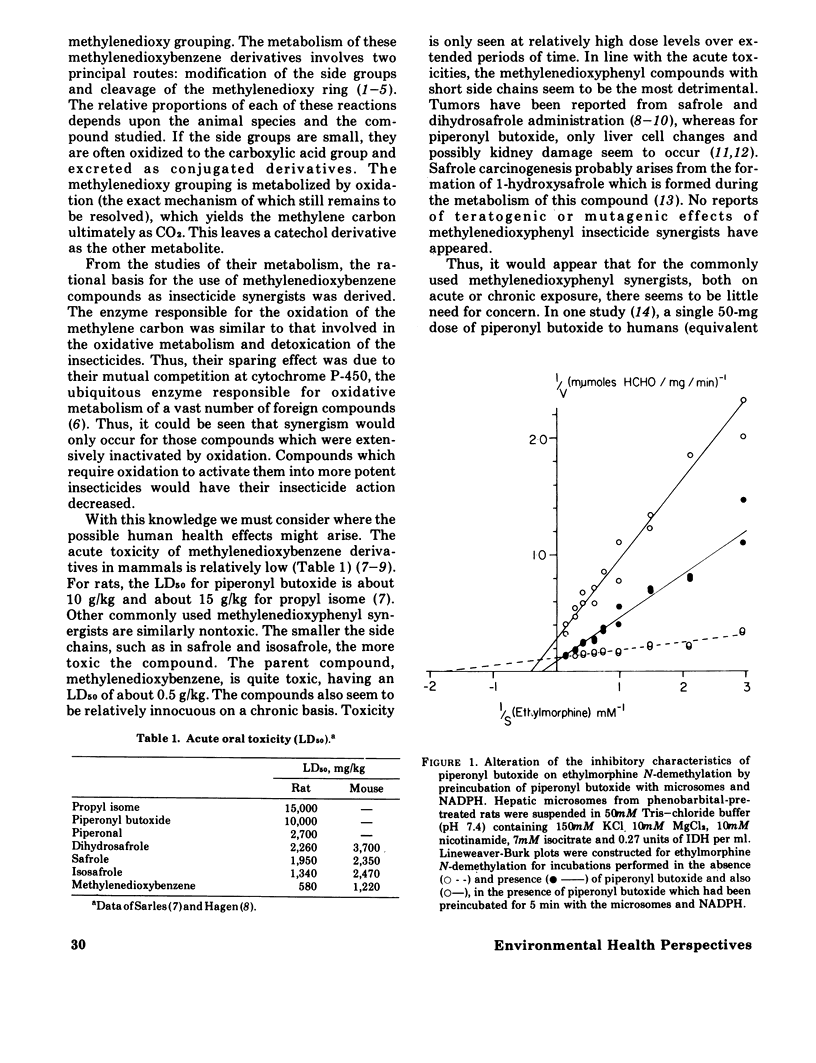
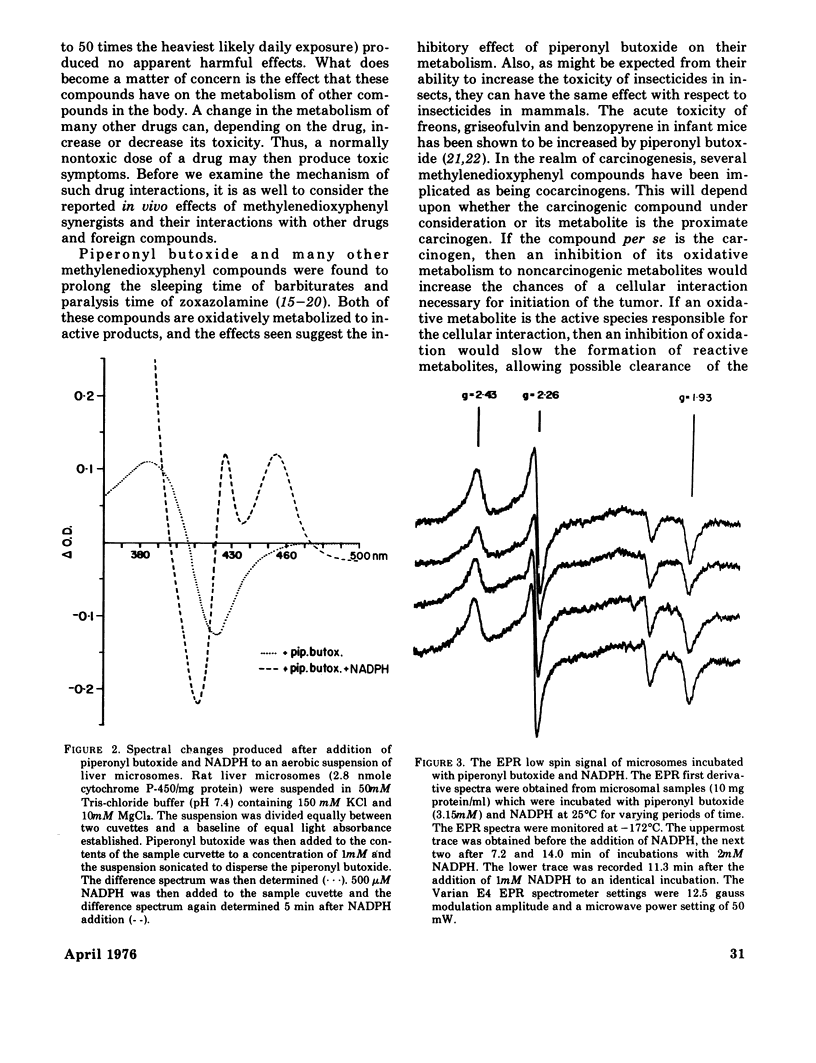
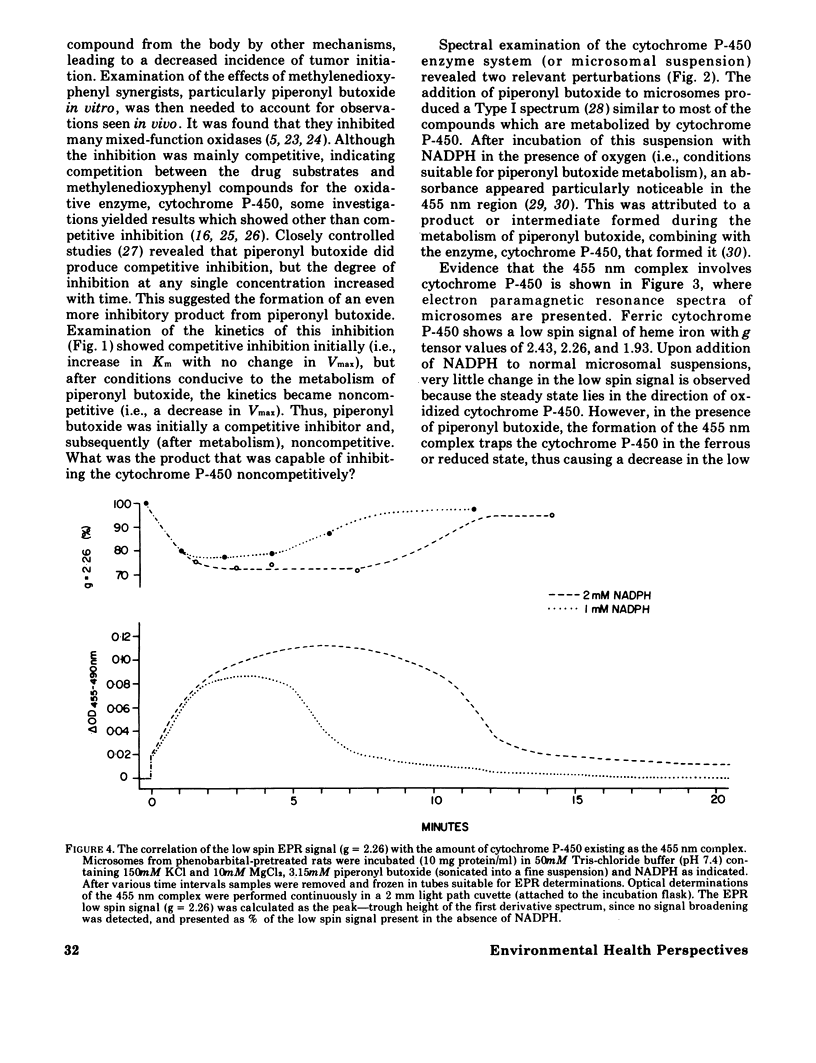
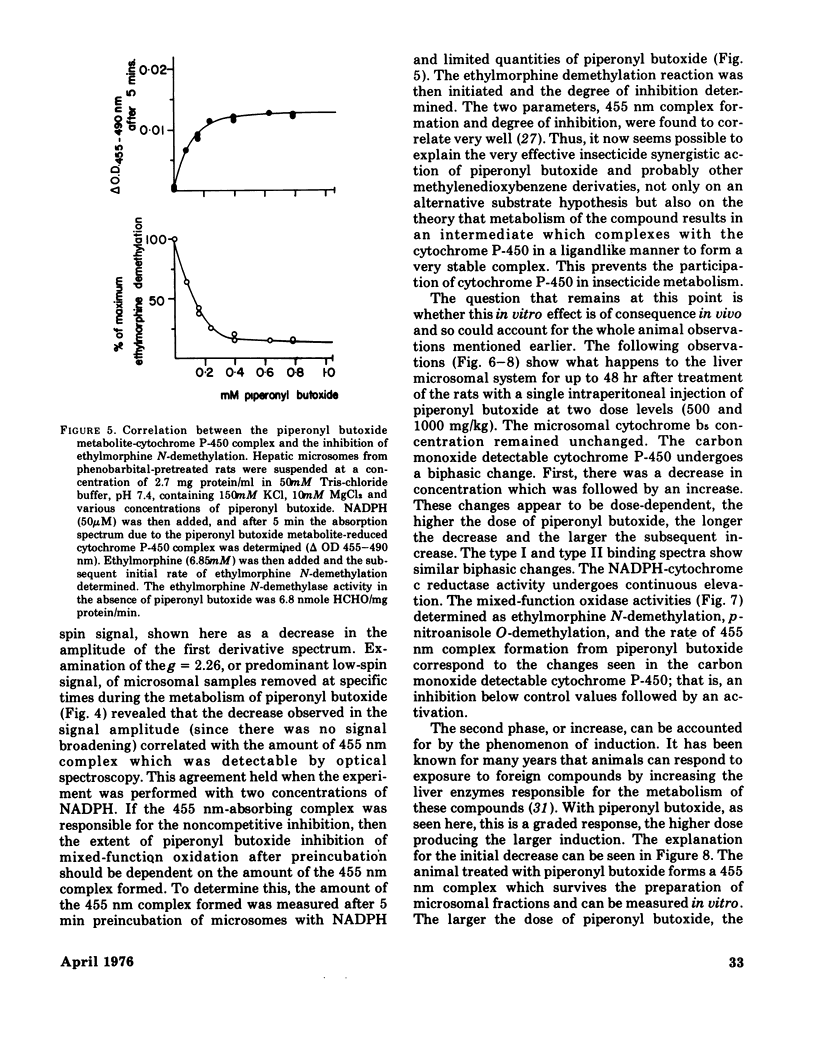

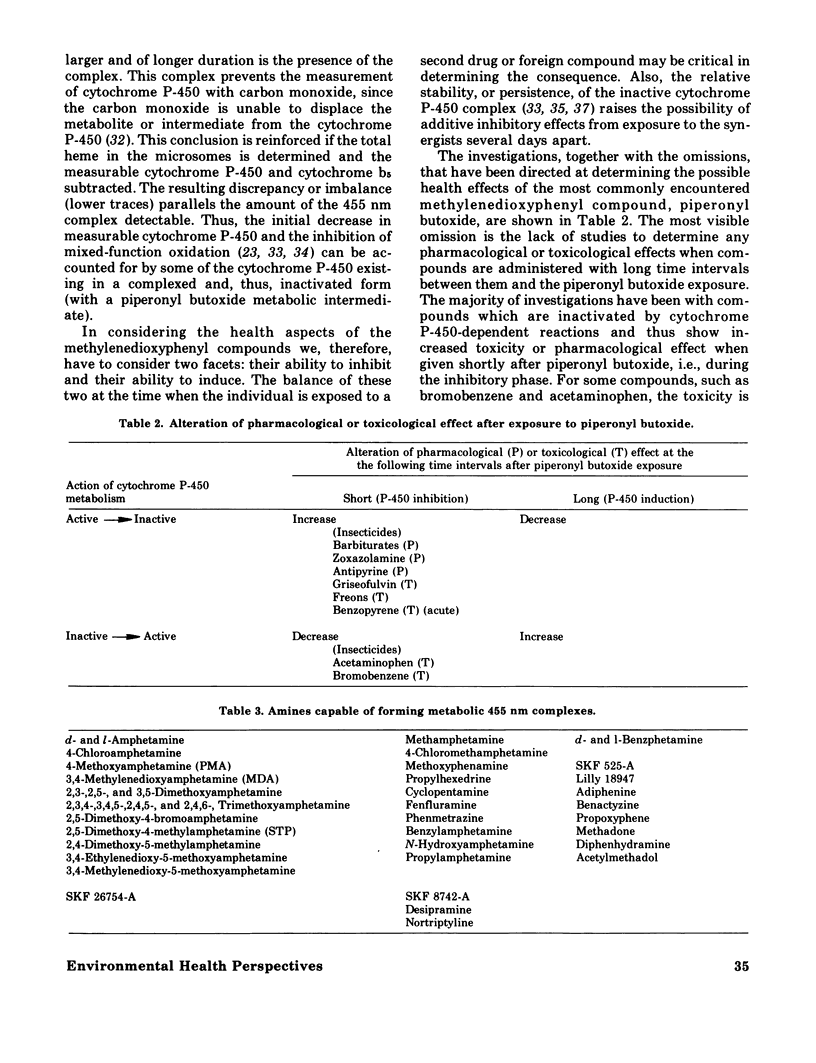
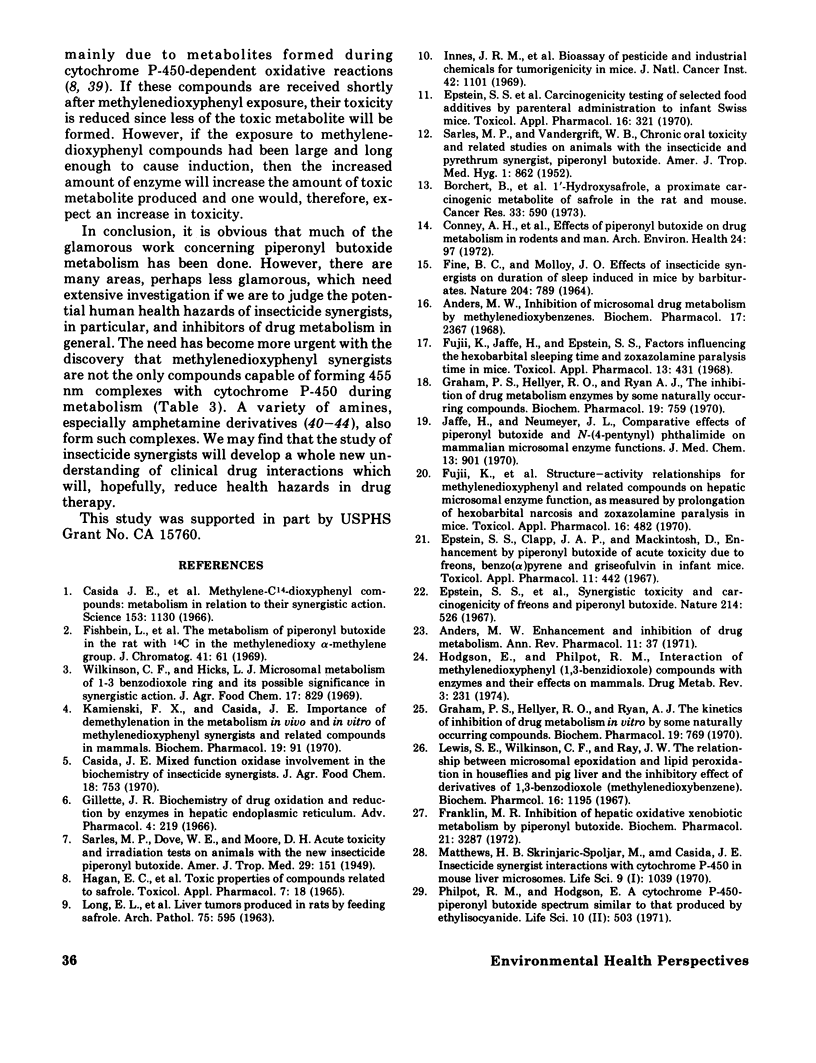
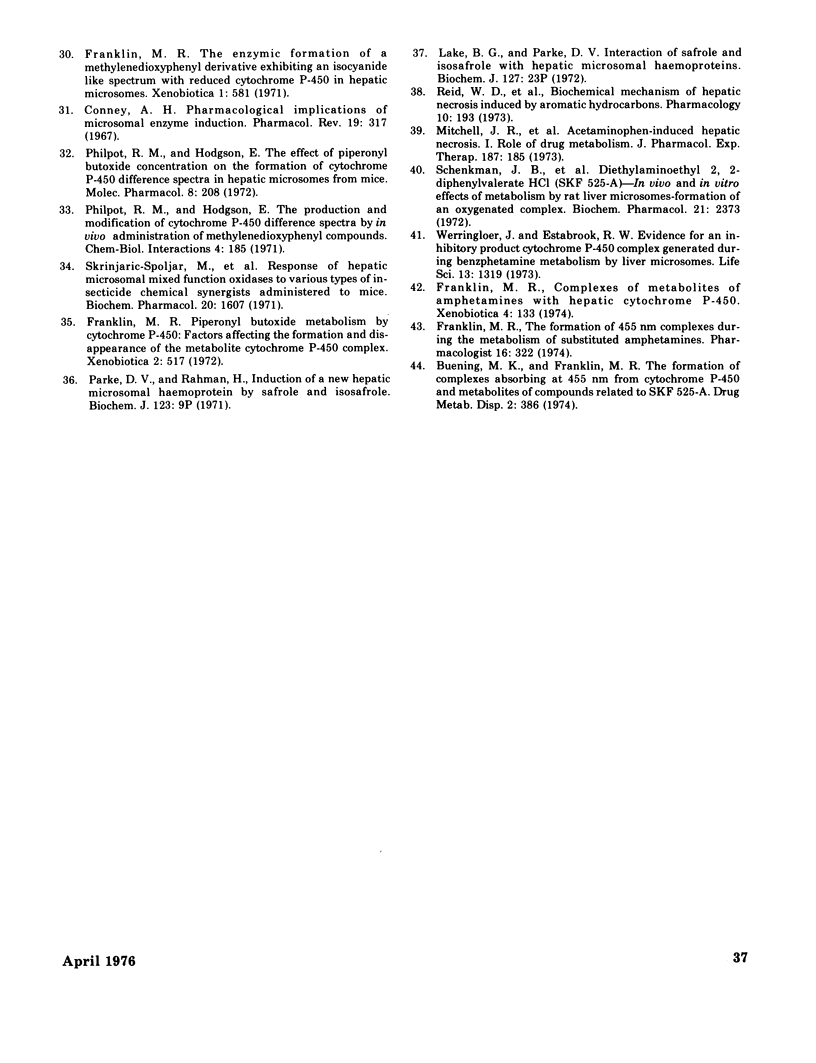
Selected References
These references are in PubMed. This may not be the complete list of references from this article.
- Anders M. W. Enhancement and inhibition of drug metabolism. Annu Rev Pharmacol. 1971;11:37–56. doi: 10.1146/annurev.pa.11.040171.000345. [DOI] [PubMed] [Google Scholar]
- Anders M. W. Inhibition of microsomal drug metabolism by methylenedioxybenzenes. Biochem Pharmacol. 1968 Nov;17(11):2367–2370. doi: 10.1016/0006-2952(68)90046-4. [DOI] [PubMed] [Google Scholar]
- Borchert P., Miller J. A., Miller E. C., Shires T. K. 1'-Hydroxysafrole, a proximate carcinogenic metabolite of safrole in the rat and mouse. Cancer Res. 1973 Mar;33(3):590–600. [PubMed] [Google Scholar]
- Buening M. K., Franklin M. R. The formation of complexes absorbing at 455 nm from cytochrome P-450 and metabloites of compounds related to SKF 525-A. Drug Metab Dispos. 1974 Jul-Aug;2(4):386–390. [PubMed] [Google Scholar]
- Casida J. E., Engel J. L., Essac E. G., Kamienski F. X., Kuwatsuka S. Methylene-C14-dioxyphenyl compounds: metabolism in relation to their synergistic action. Science. 1966 Sep 2;153(3740):1130–1133. doi: 10.1126/science.153.3740.1130. [DOI] [PubMed] [Google Scholar]
- Casida J. E. Mixed-function oxidase involvement in the biochemistry of insecticide synergists. J Agric Food Chem. 1970 Sep-Oct;18(5):753–772. doi: 10.1021/jf60171a013. [DOI] [PubMed] [Google Scholar]
- Conney A. H., Chang R., Levin W. M., Garbut A., Munro-Faure A. D., Peck A. W., Bye A. Effects of piperonyl butoxide on drug metabolism in rodents and man. Arch Environ Health. 1972 Feb;24(2):97–106. doi: 10.1080/00039896.1972.10666058. [DOI] [PubMed] [Google Scholar]
- Conney A. H. Pharmacological implications of microsomal enzyme induction. Pharmacol Rev. 1967 Sep;19(3):317–366. [PubMed] [Google Scholar]
- Epstein S. S., Andrea J., Clapp P., Mackintosh D. Enhancement by piperonyl butoxide of acute toxicity due to Freons, benzo[alpha]pyrene, and griseofulvin in infant mice. Toxicol Appl Pharmacol. 1967 Nov;11(3):442–448. doi: 10.1016/0041-008x(67)90045-2. [DOI] [PubMed] [Google Scholar]
- Epstein S. S., Fujii K., Andrea J., Mantel N. Carcinogenicity testing of selected food additives by parenteral administration to infant Swiss mice. Toxicol Appl Pharmacol. 1970 Mar;16(2):321–334. doi: 10.1016/0041-008x(70)90004-9. [DOI] [PubMed] [Google Scholar]
- Epstein S. S., Joshi S., Andrea J., Clapp P., Flak H., Mantel N. Synergistic toxicity and carcinogenicity of 'freons' and piperonyl butoxide. Nature. 1967 Apr 29;214(5087):526–528. doi: 10.1038/214526a0. [DOI] [PubMed] [Google Scholar]
- FINE B. C., MOLLOY J. O. EFFECTS OF INSECTICIDE SYNERGISTS ON DURATION OF SLEEP INDUCED IN MICE BY BARBITURATES. Nature. 1964 Nov 21;204:789–790. doi: 10.1038/204789b0. [DOI] [PubMed] [Google Scholar]
- Franklin M. R. Inhibition of hepatic oxidative xenobiotic metabolism by piperonyl butoxide. Biochem Pharmacol. 1972 Dec 15;21(24):3287–3299. doi: 10.1016/0006-2952(72)90093-7. [DOI] [PubMed] [Google Scholar]
- Franklin M. R. Piperonyl butoxide metabolism by cytochrome P-450: factors affecting the formation and disappearance of the metabolite-cytochrome P-450 complex. Xenobiotica. 1972 Nov;2(6):517–527. doi: 10.3109/00498257209111080. [DOI] [PubMed] [Google Scholar]
- Franklin M. R. The enzymic formation of methylenedioxyphenyl derivative exhibiting an isocyanide-like spectrum with reduced cytochrome P-450 in hepatic microsomes. Xenobiotica. 1971 Nov;1(6):581–591. doi: 10.3109/00498257109112269. [DOI] [PubMed] [Google Scholar]
- Fujii K., Jaffe H., Bishop Y., Arnold E., Mackintosh D., Epstein S. S. Structure-activity relations for methylenedioxyphenyl and related compounds on hepatic microsomal enzyme function, as measured by prolongation of hexobarbital narcosis and zoxazolamine paralysis in mice. Toxicol Appl Pharmacol. 1970 Mar;16(2):482–494. doi: 10.1016/0041-008x(70)90022-0. [DOI] [PubMed] [Google Scholar]
- Fujii K., Jaffe H., Epstein S. S. Factors influencing the hexobarbital sleeping time and zoxazolamine paralysis time in mice. Toxicol Appl Pharmacol. 1968 Nov;13(3):431–438. doi: 10.1016/0041-008x(68)90119-1. [DOI] [PubMed] [Google Scholar]
- Gillette J. R. Biochemistry of drug oxidation and reduction by enzymes in hepatic endoplasmic reticulum. Adv Pharmacol. 1966;4:219–261. doi: 10.1016/s1054-3589(08)60100-3. [DOI] [PubMed] [Google Scholar]
- Graham P. S., Hellyer R. O., Ryan A. J. The inhibition of drug metabolism enzymes by some naturally occurring compounds. Biochem Pharmacol. 1970 Mar;19(3):759–768. doi: 10.1016/0006-2952(70)90239-x. [DOI] [PubMed] [Google Scholar]
- Graham P. S., Hellyer R. O., Ryan A. J. The kinetics of inhibition of drug metabolism in vitro by some naturally occurring compounds. Biochem Pharmacol. 1970 Mar;19(3):769–775. doi: 10.1016/0006-2952(70)90240-6. [DOI] [PubMed] [Google Scholar]
- HAGAN E. C., JENNER P. M., JONES W. I., FITZHUGH O. G., LONG E. L., BROUWER J. G., WEBB W. K. TOXIC PROPERTIES OF COMPOUNDS RELATED TO SAFROLE. Toxicol Appl Pharmacol. 1965 Jan;7:18–24. doi: 10.1016/0041-008x(65)90069-4. [DOI] [PubMed] [Google Scholar]
- Hodgson E., Philpot R. M. Interaction of methylenedioxyphenyl (1,3-benzodioxole) compounds with enzymes and their effects on mammals. Drug Metab Rev. 1974;3(2):231–301. doi: 10.3109/03602537408993744. [DOI] [PubMed] [Google Scholar]
- Innes J. R., Ulland B. M., Valerio M. G., Petrucelli L., Fishbein L., Hart E. R., Pallotta A. J., Bates R. R., Falk H. L., Gart J. J. Bioassay of pesticides and industrial chemicals for tumorigenicity in mice: a preliminary note. J Natl Cancer Inst. 1969 Jun;42(6):1101–1114. [PubMed] [Google Scholar]
- Jaffe H., Neumeyer J. L. Comparative effects of piperonyl butoxide and N-(4-pentynyl)phthalimide on mammalian microsomal enzyme functions. J Med Chem. 1970 Sep;13(5):901–903. doi: 10.1021/jm00299a024. [DOI] [PubMed] [Google Scholar]
- Kamienski F. X., Casida J. E. Importance of demethylenation in the metabolism in vivo and in vitro of methylenedioxyphenyl synergists and related compounds in mammals. Biochem Pharmacol. 1970 Jan;19(1):91–112. doi: 10.1016/0006-2952(70)90331-x. [DOI] [PubMed] [Google Scholar]
- Lake B. G., Parke D. V. Interaction of safrole and isosafrole with hepatic microsomal haemoproteins. Biochem J. 1972 Apr;127(2):23P–23P. doi: 10.1042/bj1270023pa. [DOI] [PMC free article] [PubMed] [Google Scholar]
- Lewis S. E., Wilkinson C. F., Ray J. W. The relationship between microsomal epoxidation and lipid peroxidation in houseflies and pig liver and the inhibitory effect of derivatives of 1,3-benzodiozole (methylenedioxybenzene). Biochem Pharmacol. 1967 Jul 7;16(7):1195–1210. doi: 10.1016/0006-2952(67)90151-7. [DOI] [PubMed] [Google Scholar]
- Matthews H. B., Skrinjarić-Spoljar M., Casida J. E. Insecticide synergist interactions with cytochrome P-450 in mouse liver microsomes. Life Sci I. 1970 Sep 15;9(18):1039–1048. doi: 10.1016/0024-3205(70)90107-4. [DOI] [PubMed] [Google Scholar]
- Mitchell J. R., Jollow D. J., Potter W. Z., Davis D. C., Gillette J. R., Brodie B. B. Acetaminophen-induced hepatic necrosis. I. Role of drug metabolism. J Pharmacol Exp Ther. 1973 Oct;187(1):185–194. [PubMed] [Google Scholar]
- Parke D. V., Rahman H. Induction of a new hepatic microsomal haemoprotein by safrole and isosafrole. Biochem J. 1971 Jun;123(2):9P–10P. doi: 10.1042/bj1230009pb. [DOI] [PMC free article] [PubMed] [Google Scholar]
- Philpot R. M., Hodgson E. A cytochrome P-450-piperonyl butoxide spectrum similar to that produced by ethyl isocyanide. Life Sci II. 1971 May 8;10(9):503–512. doi: 10.1016/0024-3205(71)90124-x. [DOI] [PubMed] [Google Scholar]
- Philpot R. M., Hodgson E. The production and modification of cytochrome P-450 difference spectra by in vivo administration of methylenedioxyphenyl compounds. Chem Biol Interact. 1972 Feb;4(3):185–194. doi: 10.1016/0009-2797(72)90013-0. [DOI] [PubMed] [Google Scholar]
- Reid W. D., Krishna G., Gillette R., Brodie B. B. Biochemical mechanism of hepatic necrosis induced by aromatic hydrocarbons. Pharmacology. 1973;10(4):193–214. doi: 10.1159/000136440. [DOI] [PubMed] [Google Scholar]
- SARLES M. P., VANDEGRIFT W. B. Chronic oral toxicity and related studies on animals with the insecticide and pyrethrum synergist, piperonyl butoxide. Am J Trop Med Hyg. 1952 Sep;1(5):862–883. doi: 10.4269/ajtmh.1952.1.862. [DOI] [PubMed] [Google Scholar]
- Schenkman J. B., Wilson B. J., Cinti D. L. Dimethylaminoethyl 2,2-diphenylvalerate HCl (SKF 525-A)--in vivo and in vitro effects of metabolism by rat liver microsomes--formation of an oxygenated complex. Biochem Pharmacol. 1972 Sep 1;21(17):2373–2383. doi: 10.1016/0006-2952(72)90389-9. [DOI] [PubMed] [Google Scholar]
- Skrinjarić-Spoljar M., Matthews H. B., Engel J. L., Casida J. E. Response of hepatic microsomal mixed-function oxidases to various types of insecticide chemical synergists administered to mice. Biochem Pharmacol. 1971 Jul;20(7):1607–1618. doi: 10.1016/0006-2952(71)90289-9. [DOI] [PubMed] [Google Scholar]
- Werringloer J., Estabrook R. W. Evidence for an inhibitory product-cytochrome P-450 complex generated during benzphetamine metabolism by liver microsomes. Life Sci. 1973 Nov 16;13(10):1319–1330. doi: 10.1016/0024-3205(73)90153-7. [DOI] [PubMed] [Google Scholar]


